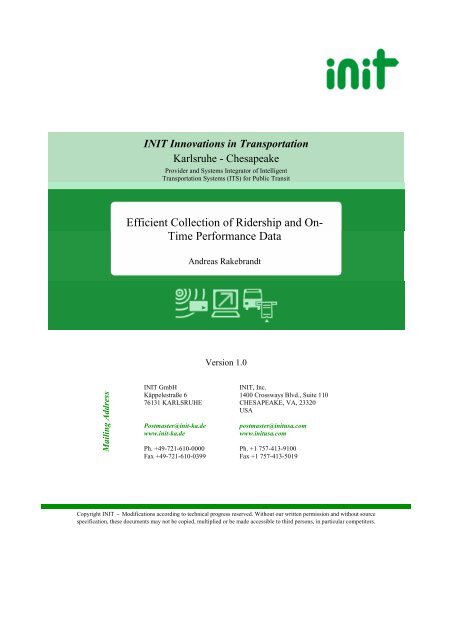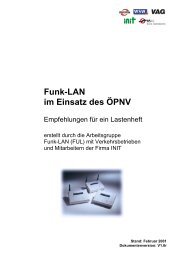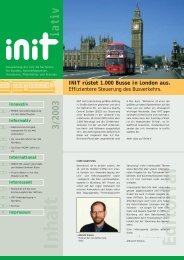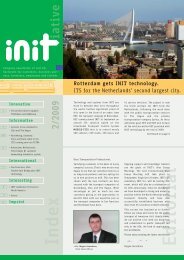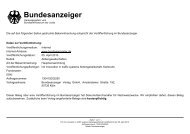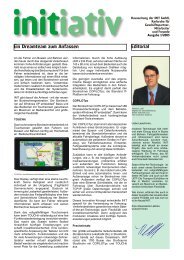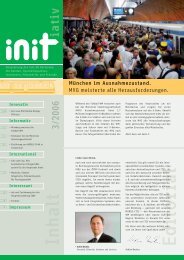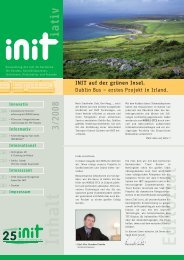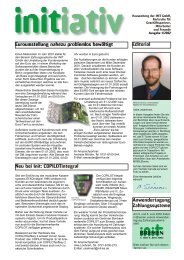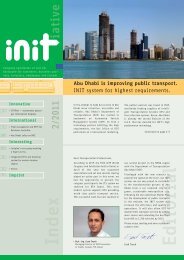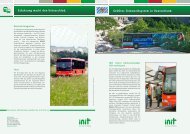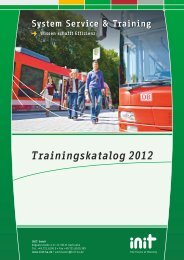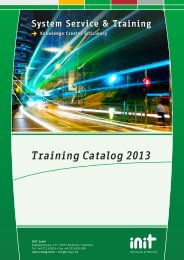Efficient Collection of Ridership and On- Time Performance Data - Init
Efficient Collection of Ridership and On- Time Performance Data - Init
Efficient Collection of Ridership and On- Time Performance Data - Init
Create successful ePaper yourself
Turn your PDF publications into a flip-book with our unique Google optimized e-Paper software.
INIT Innovations in Transportation<br />
Karlsruhe - Chesapeake<br />
Provider <strong>and</strong> Systems Integrator <strong>of</strong> Intelligent<br />
Transportation Systems (ITS) for Public Transit<br />
<strong>Efficient</strong> <strong>Collection</strong> <strong>of</strong> <strong>Ridership</strong> <strong>and</strong> <strong>On</strong>-<br />
<strong>Time</strong> <strong>Performance</strong> <strong>Data</strong><br />
Andreas Rakebr<strong>and</strong>t<br />
Version 1.0<br />
Mailing Address<br />
INIT GmbH<br />
Käppelestraße 6<br />
76131 KARLSRUHE<br />
Postmaster@init-ka.de<br />
www.init-ka.de<br />
Ph. +49-721-610-0000<br />
Fax +49-721-610-0399<br />
INIT, Inc.<br />
1400 Crossways Blvd., Suite 110<br />
CHESAPEAKE, VA, 23320<br />
USA<br />
postmaster@initusa.com<br />
www.initusa.com<br />
Ph. +1 757-413-9100<br />
Fax +1 757-413-5019<br />
Copyright INIT - Modifications according to technical progress reserved. Without our written permission <strong>and</strong> without source<br />
specification, these documents may not be copied, multiplied or be made accessible to third persons, in particular competitors.
Automatic Passenger Counting<br />
<strong>Efficient</strong> <strong>Collection</strong> <strong>of</strong> <strong>Ridership</strong> <strong>and</strong> <strong>On</strong>-<strong>Time</strong> <strong>Performance</strong> <strong>Data</strong><br />
Table <strong>of</strong> Contents<br />
Table <strong>of</strong> Contents<br />
1 Introduction........................................................................................................................ 3<br />
1.1 Technical Overview ................................................................................................ 3<br />
1.2 Partnership............................................................................................................... 3<br />
2 Vehicle System.................................................................................................................... 4<br />
2.1 Vehicle Counting Components ............................................................................... 5<br />
2.1.1 Infrared Array Sensor................................................................................ 6<br />
2.1.2 The Analyzer Unit..................................................................................... 8<br />
2.2 GPS Receiver .......................................................................................................... 8<br />
2.3 <strong>On</strong>-Board Computer COPILOTsmart with Integrated WLAN............................... 8<br />
2.4 Required Signals...................................................................................................... 8<br />
2.5 Network Overview .................................................................................................. 8<br />
2.6 St<strong>and</strong>ard <strong>Data</strong> Receiving Unit: WLANstation (Garage server) .............................. 9<br />
2.7 <strong>Data</strong> Security ........................................................................................................... 9<br />
3 Central System..................................................................................................................10<br />
3.1 Reports................................................................................................................... 11
Automatic Passenger Counting<br />
<strong>Efficient</strong> <strong>Collection</strong> <strong>of</strong> <strong>Ridership</strong> <strong>and</strong> <strong>On</strong>-<strong>Time</strong> <strong>Performance</strong> <strong>Data</strong><br />
Introduction<br />
1 Introduction<br />
Reliable ridership data is not only important for government reporting but also necessary to help<br />
better plan public transit services. The costs <strong>and</strong> efforts for manual passenger counting are extremely<br />
high, the sampling plans are <strong>of</strong>ten not representative <strong>and</strong> the results are inaccurate. Automatic<br />
Passenger Counting (APC) collects highly accurate ridership data <strong>and</strong> no manual ride<br />
checkers are needed. APC is <strong>of</strong>ten integrated into an Automatic Vehicle Location (AVL) system,<br />
however also available as a st<strong>and</strong> alone system. This st<strong>and</strong> alone version allows transit agencies<br />
who don’t have an AVL system to benefit from the advantages APC <strong>of</strong>fers.<br />
Metro in St. Louis is using APC as a st<strong>and</strong>alone system on 40 buses <strong>and</strong> 87 LRV’s. In particular,<br />
APC data was a critical component in the service reduction analysis in 2004 when approximately<br />
$2 million dollars per year were saved through the service reduction without significantly<br />
impacting overall ridership. In order to manually collect, analyze <strong>and</strong> manage the<br />
route data which Metro receives from the Automatic Passenger Counting System, the agency<br />
would have to spend a minimum <strong>of</strong> $700,000 per year. Metro measures on-time at every time<br />
point for arrival <strong>and</strong> departure. In addition, the data is stored in a shared network drive so operations<br />
can review how an operator is performing by printing the history <strong>and</strong> going over with the<br />
operator how to improve the schedule adherence.<br />
1.1 Technical Overview<br />
Infrared sensors, mounted above each door, combine passive <strong>and</strong> active technology to achieve<br />
highest accuracy. The sensors are connected to an on-board computer which retrieves <strong>and</strong> stores<br />
the counts together with GPS location. As soon as the vehicle arrives in the garage area the collected<br />
data is uploaded wireless LAN from the vehicles to a central server. A unique algorithm<br />
which does not require any manual intervention matches the passenger counts to the schedule. A<br />
projection feature extrapolates sample data to the full service. It should be specifically noted that<br />
no driver interaction is required (“black box” solution). The turnkey APC system works from<br />
end to end fully automated! All data is subsequently available in database for ad-hoc <strong>and</strong> automatically<br />
scheduled statistical reports. Results are presented in tables, graphs <strong>and</strong> in a graphical<br />
information system (GIS). NTD reporting is integrated.<br />
1.2 Partnership<br />
INIT has more than 6500 sensors installed in North America <strong>and</strong> Canada on buses <strong>and</strong> Light Rail<br />
Vehicles. The APC system has been developed in conjunction with INIT´s cooperation partner<br />
IRIS Infrared & Intelligent Sensors GmbH, Berlin (INIT AG is major shareholder <strong>of</strong> IRIS<br />
GmbH).<br />
Andreas Rakebr<strong>and</strong>t 05-08-02<br />
C:\Dokumente und Einstellungen\bau\Lokale Einstellungen\Temporary Internet Files\OLK2A\APC_Paper_RAK_2.doc<br />
TAB 5, A <strong>Efficient</strong> <strong>Collection</strong> <strong>of</strong> <strong>Ridership</strong> <strong>and</strong> <strong>On</strong>-<strong>Time</strong> <strong>Performance</strong> <strong>Data</strong> Page 3 <strong>of</strong> 13<br />
This document contains proprietary information <strong>and</strong> has to be treated confidentially.
Automatic Passenger Counting<br />
<strong>Efficient</strong> <strong>Collection</strong> <strong>of</strong> <strong>Ridership</strong> <strong>and</strong> <strong>On</strong>-<strong>Time</strong> <strong>Performance</strong> <strong>Data</strong><br />
Vehicle System<br />
2 Vehicle System<br />
The st<strong>and</strong>ard APC system consists <strong>of</strong> components to count people <strong>and</strong> components to store,<br />
transmit <strong>and</strong> evaluate the count data as shown in Figure 1.<br />
Figure 1: Overview Of The St<strong>and</strong>ard APC Components<br />
Andreas Rakebr<strong>and</strong>t 05-08-02<br />
C:\Dokumente und Einstellungen\bau\Lokale Einstellungen\Temporary Internet Files\OLK2A\APC_Paper_RAK_2.doc<br />
TAB 5, A <strong>Efficient</strong> <strong>Collection</strong> <strong>of</strong> <strong>Ridership</strong> <strong>and</strong> <strong>On</strong>-<strong>Time</strong> <strong>Performance</strong> <strong>Data</strong> Page 4 <strong>of</strong> 13<br />
This document contains proprietary information <strong>and</strong> has to be treated confidentially.
Automatic Passenger Counting<br />
<strong>Efficient</strong> <strong>Collection</strong> <strong>of</strong> <strong>Ridership</strong> <strong>and</strong> <strong>On</strong>-<strong>Time</strong> <strong>Performance</strong> <strong>Data</strong><br />
Vehicle System<br />
The APC System in the vehicle consists <strong>of</strong> the following modules:<br />
• <strong>On</strong>-Board Computer COPILOTsmart including the WLAN unit<br />
• GPS-Receiver<br />
• Passenger counting sensors<br />
• Passenger counting analyzer<br />
The core unit <strong>of</strong> the vehicle system is INIT’s on-board computer, COPILOTsmart which stores<br />
the APC data received from the analyzer unit(s), <strong>and</strong> transmits the data via <strong>Data</strong> Transmission<br />
Unit to the post-processing system for evaluation <strong>and</strong> analysis.<br />
2.1 Vehicle Counting Components<br />
The sensors are installed above the door. The typical counting components for a LRV are shown<br />
in the picture below. Four analyzers are needed per train, (one analyzer for two doors), 16 sensors<br />
per train, (2 sensors per door), 1 COPILOTsmart per train. A bus will need at least two sensors,<br />
one analyzer.<br />
Figure 2: Basic Components Of The IRMA APC System<br />
The figure includes the following components:<br />
Andreas Rakebr<strong>and</strong>t 05-08-02<br />
C:\Dokumente und Einstellungen\bau\Lokale Einstellungen\Temporary Internet Files\OLK2A\APC_Paper_RAK_2.doc<br />
TAB 5, A <strong>Efficient</strong> <strong>Collection</strong> <strong>of</strong> <strong>Ridership</strong> <strong>and</strong> <strong>On</strong>-<strong>Time</strong> <strong>Performance</strong> <strong>Data</strong> Page 5 <strong>of</strong> 13<br />
This document contains proprietary information <strong>and</strong> has to be treated confidentially.
Automatic Passenger Counting<br />
<strong>Efficient</strong> <strong>Collection</strong> <strong>of</strong> <strong>Ridership</strong> <strong>and</strong> <strong>On</strong>-<strong>Time</strong> <strong>Performance</strong> <strong>Data</strong><br />
Vehicle System<br />
• "IRMA" vertical infrared array sensors detect the number <strong>and</strong> direction <strong>of</strong> movement <strong>of</strong><br />
boarding <strong>and</strong>/or de-boarding passengers. The dimensions <strong>of</strong> the housing are 90x32x34 mm =<br />
3.54x1.26x1.34” (LxWxH). Two sensors per a wide door (Door width 48”)<br />
• The sensor consists <strong>of</strong> active <strong>and</strong> passive components to eliminate as many errors as possible.<br />
• Due to inner <strong>and</strong> outer curtain, the intelligent sensor is able to distinguish between boarding<br />
/de-boarding passengers.<br />
The sensor is self calibrating the active <strong>and</strong> passive sensing components after the door is<br />
closed. NO further adjustments are necessary!<br />
• „IRMA" analyzer unit (connected to the sensors) transforms the infrared information provided<br />
by the sensors into passenger counts per direction per door <strong>and</strong> transmits the data to the<br />
on-board COPILOTsmart.<br />
• The analyzer is connected to on-board computer COPILOTsmart which, after each stop, interrogates<br />
the results with regard to counts at each door <strong>and</strong> distinction between “ons“ <strong>and</strong><br />
“<strong>of</strong>fs“ <strong>and</strong> stores the data in correlation with GPS <strong>and</strong> time. The door contact input <strong>of</strong> the<br />
analyzers is connected to the train line to receive the door open <strong>and</strong> close signal.<br />
• Cables <strong>and</strong> connectors between sensors, passenger counter <strong>and</strong> on-board storage device<br />
2.1.1 Infrared Array Sensor<br />
The main component <strong>of</strong> the APC system is the sensor. The sensor consists <strong>of</strong> three components:<br />
• Passive component (pyro-electric detector)<br />
• Active component (light scanner)<br />
• Combined photo diodes (constant light receiver)<br />
Andreas Rakebr<strong>and</strong>t 05-08-02<br />
C:\Dokumente und Einstellungen\bau\Lokale Einstellungen\Temporary Internet Files\OLK2A\APC_Paper_RAK_2.doc<br />
TAB 5, A <strong>Efficient</strong> <strong>Collection</strong> <strong>of</strong> <strong>Ridership</strong> <strong>and</strong> <strong>On</strong>-<strong>Time</strong> <strong>Performance</strong> <strong>Data</strong> Page 6 <strong>of</strong> 13<br />
This document contains proprietary information <strong>and</strong> has to be treated confidentially.
Automatic Passenger Counting<br />
<strong>Efficient</strong> <strong>Collection</strong> <strong>of</strong> <strong>Ridership</strong> <strong>and</strong> <strong>On</strong>-<strong>Time</strong> <strong>Performance</strong> <strong>Data</strong><br />
Vehicle System<br />
Figure 3a: Sensor Description<br />
Passive Component<br />
Active Component<br />
The detector contains 6 detector elements, the The detection range <strong>of</strong> the light scanner is<br />
detection range <strong>of</strong> which has been arranged as also arranged as two “parallel” curtains.<br />
two “parallel” curtains.<br />
Andreas Rakebr<strong>and</strong>t 05-08-02<br />
Figure 3b: Arrangement Of Sensor Detection Area<br />
When a person passes the recording area <strong>of</strong> the sensor, he/she is “viewed” by both the passive<br />
component <strong>and</strong> the active component as well as by the double photo diode. All signals generated<br />
in the sensor are amplified <strong>and</strong> digitized by the sensor <strong>and</strong> then transmitted to the analyzer unit<br />
via synchronous serial interface. The signals are transformed into counts by the analyzer unit.<br />
C:\Dokumente und Einstellungen\bau\Lokale Einstellungen\Temporary Internet Files\OLK2A\APC_Paper_RAK_2.doc<br />
TAB 5, A <strong>Efficient</strong> <strong>Collection</strong> <strong>of</strong> <strong>Ridership</strong> <strong>and</strong> <strong>On</strong>-<strong>Time</strong> <strong>Performance</strong> <strong>Data</strong> Page 7 <strong>of</strong> 13<br />
This document contains proprietary information <strong>and</strong> has to be treated confidentially.
Automatic Passenger Counting<br />
<strong>Efficient</strong> <strong>Collection</strong> <strong>of</strong> <strong>Ridership</strong> <strong>and</strong> <strong>On</strong>-<strong>Time</strong> <strong>Performance</strong> <strong>Data</strong><br />
Vehicle System<br />
2.1.2 The Analyzer Unit<br />
From the signals transmitted by the sensor(s), the analyzer determines the number <strong>of</strong> persons getting<br />
on <strong>and</strong> <strong>of</strong>f the vehicle. These counts are interrogated <strong>and</strong> stored by the on-board computer.<br />
The data are transmitted from the analyzer to the on-board computer via dedicated data cable.<br />
2.2 GPS Receiver<br />
A GPS receiver is providing every 4 seconds the vehicle position.<br />
2.3 <strong>On</strong>-Board Computer COPILOTsmart with Integrated WLAN<br />
The core unit <strong>of</strong> INIT’s on-board APC equipment is the COPILOTsmart computer <strong>and</strong> acting as<br />
the interface to both the vehicle electronics such as Automatic Passenger Counting system <strong>and</strong><br />
the vehicle location component such as GPS. With the integrated WLAN card it is utilized as the<br />
link between the APC equipment <strong>and</strong> the post-processing system.<br />
2.4 Required Signals<br />
• No Motion Signal (LRV)<br />
• Odometer (Bus)<br />
• Door Open Sensor<br />
• Ignition<br />
• Battery Power<br />
2.5 Network Overview<br />
The Access point is installed at the garage. As soon as the vehicle arrives in the range <strong>of</strong> the access<br />
point the data is transmitted to the Wlan Garage server.<br />
The FTP client on the central server retrieves the data from the garage server <strong>and</strong> the data is<br />
matched with the schedule information once a day. The matched APC information is exported<br />
into MOBILEstatatistics <strong>and</strong> available for reporting. All reports can be accessed through the Oracle<br />
data base.<br />
Andreas Rakebr<strong>and</strong>t 05-08-02<br />
C:\Dokumente und Einstellungen\bau\Lokale Einstellungen\Temporary Internet Files\OLK2A\APC_Paper_RAK_2.doc<br />
TAB 5, A <strong>Efficient</strong> <strong>Collection</strong> <strong>of</strong> <strong>Ridership</strong> <strong>and</strong> <strong>On</strong>-<strong>Time</strong> <strong>Performance</strong> <strong>Data</strong> Page 8 <strong>of</strong> 13<br />
This document contains proprietary information <strong>and</strong> has to be treated confidentially.
Automatic Passenger Counting<br />
<strong>Efficient</strong> <strong>Collection</strong> <strong>of</strong> <strong>Ridership</strong> <strong>and</strong> <strong>On</strong>-<strong>Time</strong> <strong>Performance</strong> <strong>Data</strong><br />
Vehicle System<br />
2.6 St<strong>and</strong>ard <strong>Data</strong> Receiving Unit: WLANstation (Garage server)<br />
Additionally to the wireless LAN clients (COPILOTsmart) in the vehicles, some infrastructure is<br />
needed for the WLAN network on stationary side. To build a wireless network, garage stations<br />
called access points (AP) are used. Every AP has a maximum communication range <strong>of</strong> 500 feet.<br />
Also, one wireless LAN server (PC) is needed on the garage location. The PC is the main communication<br />
partner <strong>of</strong> the COPILOTsmart. The access point is connected to the Server (WLANstation)<br />
through the Ethernet network. The WLANstation server contains two network cards in<br />
order to separate the APC network from the company network.<br />
2.7 <strong>Data</strong> Security<br />
Overall, wireless connections are always susceptible to allowing open access unless a protection<br />
structure has been integrated into the system. Every 802.11b compliant client adapter may log<br />
into a wireless system <strong>and</strong> transfer data. The best way to counteract the possibility <strong>of</strong> external<br />
users is by means <strong>of</strong> a customary protection based on a Cisco platform. INIT has done extensive<br />
research <strong>and</strong> has comprehensive experience in locating the safest <strong>and</strong> most reliable system available.<br />
Andreas Rakebr<strong>and</strong>t 05-08-02<br />
C:\Dokumente und Einstellungen\bau\Lokale Einstellungen\Temporary Internet Files\OLK2A\APC_Paper_RAK_2.doc<br />
TAB 5, A <strong>Efficient</strong> <strong>Collection</strong> <strong>of</strong> <strong>Ridership</strong> <strong>and</strong> <strong>On</strong>-<strong>Time</strong> <strong>Performance</strong> <strong>Data</strong> Page 9 <strong>of</strong> 13<br />
This document contains proprietary information <strong>and</strong> has to be treated confidentially.
Automatic Passenger Counting<br />
<strong>Efficient</strong> <strong>Collection</strong> <strong>of</strong> <strong>Ridership</strong> <strong>and</strong> <strong>On</strong>-<strong>Time</strong> <strong>Performance</strong> <strong>Data</strong><br />
Central System<br />
3 Central System<br />
The central system is composed <strong>of</strong> the following subsystems:<br />
• S<strong>of</strong>tware for Scheduling <strong>Data</strong> import <strong>and</strong> Management including conversion <strong>of</strong> Geocoordinates<br />
• <strong>Data</strong> Base s<strong>of</strong>tware - MOBILEcore<br />
• <strong>Data</strong> Validation <strong>and</strong> Matching s<strong>of</strong>tware<br />
• MOBILEstatistics s<strong>of</strong>tware<br />
• MOBILEstatistics server<br />
• MOBILEstatistics client s<strong>of</strong>tware<br />
As described previously in the proposal Figure 4: illustrates the data flow in the central system <strong>of</strong><br />
INIT´s APC system.<br />
Figure 4: <strong>Data</strong> Flow APC System<br />
Andreas Rakebr<strong>and</strong>t 05-08-02<br />
C:\Dokumente und Einstellungen\bau\Lokale Einstellungen\Temporary Internet Files\OLK2A\APC_Paper_RAK_2.doc<br />
TAB 5, A <strong>Efficient</strong> <strong>Collection</strong> <strong>of</strong> <strong>Ridership</strong> <strong>and</strong> <strong>On</strong>-<strong>Time</strong> <strong>Performance</strong> <strong>Data</strong> Page 10 <strong>of</strong> 13<br />
This document contains proprietary information <strong>and</strong> has to be treated confidentially.
Automatic Passenger Counting<br />
<strong>Efficient</strong> <strong>Collection</strong> <strong>of</strong> <strong>Ridership</strong> <strong>and</strong> <strong>On</strong>-<strong>Time</strong> <strong>Performance</strong> <strong>Data</strong><br />
Central System<br />
3.1 Reports<br />
Based on the data in the database, data st<strong>and</strong>ard reports <strong>and</strong> ad hoc reports can be generated. The<br />
basic MOBILEstatistics client includes the following reports:<br />
• Passenger Flow per Door<br />
• Passenger Flow per Stop<br />
• Passenger Flow per Trip<br />
• Passenger Flow per Line<br />
• Passenger Flow per Vehicle<br />
• Passenger Flow by <strong>Time</strong><br />
• Passenger Flow Overview<br />
The following screen shots show examples <strong>of</strong> APC data evaluation <strong>and</strong> post processing.<br />
Figure 5: Example for Passenger Flow per Door<br />
Andreas Rakebr<strong>and</strong>t 05-08-02<br />
C:\Dokumente und Einstellungen\bau\Lokale Einstellungen\Temporary Internet Files\OLK2A\APC_Paper_RAK_2.doc<br />
TAB 5, A <strong>Efficient</strong> <strong>Collection</strong> <strong>of</strong> <strong>Ridership</strong> <strong>and</strong> <strong>On</strong>-<strong>Time</strong> <strong>Performance</strong> <strong>Data</strong> Page 11 <strong>of</strong> 13<br />
This document contains proprietary information <strong>and</strong> has to be treated confidentially.
Automatic Passenger Counting<br />
<strong>Efficient</strong> <strong>Collection</strong> <strong>of</strong> <strong>Ridership</strong> <strong>and</strong> <strong>On</strong>-<strong>Time</strong> <strong>Performance</strong> <strong>Data</strong><br />
Central System<br />
Figure 6: Example for Passenger Flow per Stop<br />
Figure 7: <strong>Ridership</strong> per Trip by Train<br />
Andreas Rakebr<strong>and</strong>t 05-08-02<br />
C:\Dokumente und Einstellungen\bau\Lokale Einstellungen\Temporary Internet Files\OLK2A\APC_Paper_RAK_2.doc<br />
TAB 5, A <strong>Efficient</strong> <strong>Collection</strong> <strong>of</strong> <strong>Ridership</strong> <strong>and</strong> <strong>On</strong>-<strong>Time</strong> <strong>Performance</strong> <strong>Data</strong> Page 12 <strong>of</strong> 13<br />
This document contains proprietary information <strong>and</strong> has to be treated confidentially.
Automatic Passenger Counting<br />
<strong>Efficient</strong> <strong>Collection</strong> <strong>of</strong> <strong>Ridership</strong> <strong>and</strong> <strong>On</strong>-<strong>Time</strong> <strong>Performance</strong> <strong>Data</strong><br />
Central System<br />
Often times Transit Authorities will couple 2 LRV’s together to form a “Train”. As illustrated by<br />
the “<strong>Ridership</strong> per Trip by Train” report above; INT is fully capable <strong>of</strong> providing reports <strong>and</strong><br />
statistics for this type <strong>of</strong> configuration.<br />
All recorded data is available in Oracle database <strong>and</strong> it can be accessed through a third party interface<br />
module.<br />
Andreas Rakebr<strong>and</strong>t 05-08-02<br />
C:\Dokumente und Einstellungen\bau\Lokale Einstellungen\Temporary Internet Files\OLK2A\APC_Paper_RAK_2.doc<br />
TAB 5, A <strong>Efficient</strong> <strong>Collection</strong> <strong>of</strong> <strong>Ridership</strong> <strong>and</strong> <strong>On</strong>-<strong>Time</strong> <strong>Performance</strong> <strong>Data</strong> Page 13 <strong>of</strong> 13<br />
This document contains proprietary information <strong>and</strong> has to be treated confidentially.


